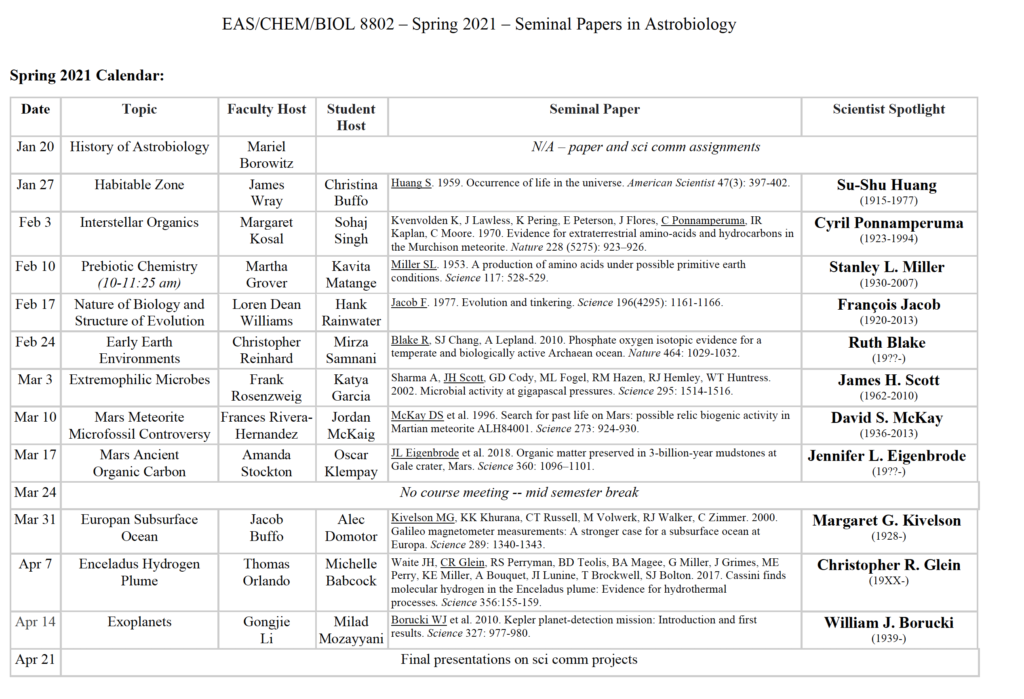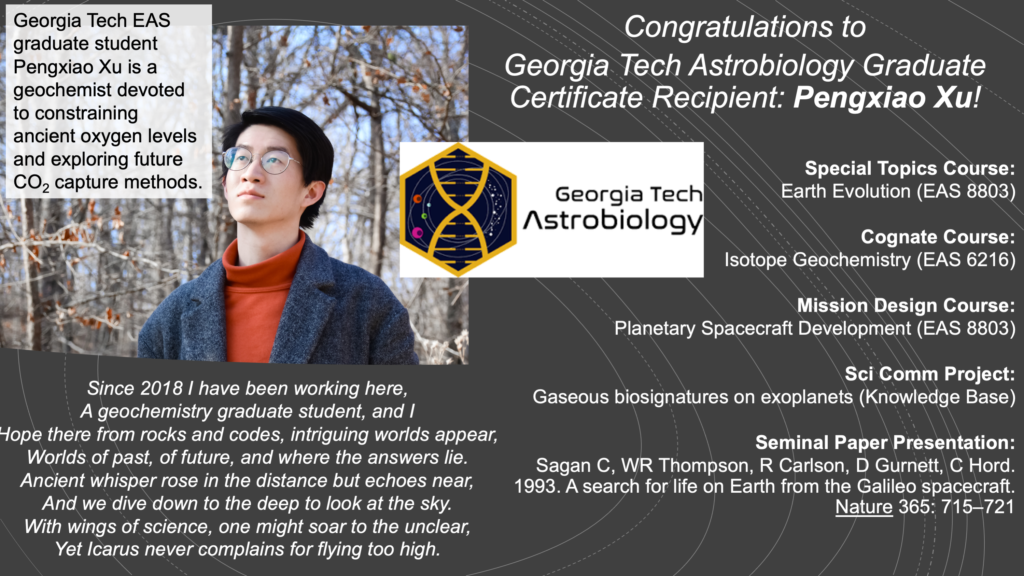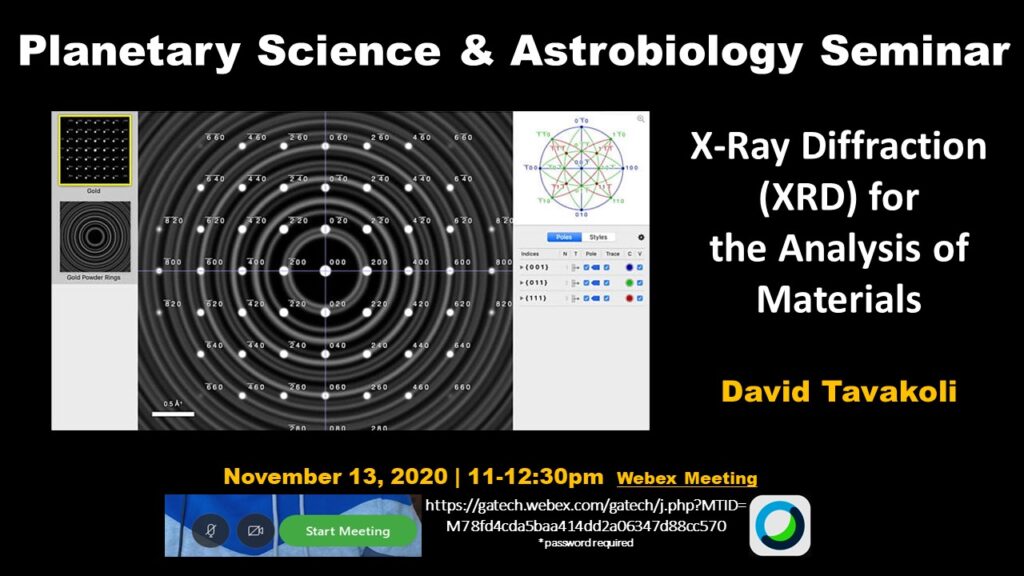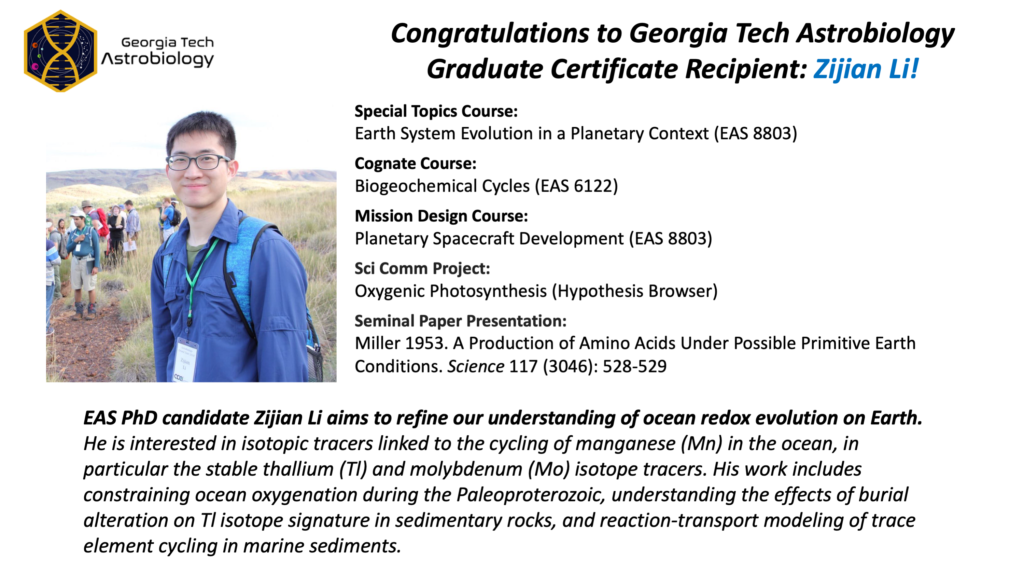Seminal Papers in Astrobiology Spring 2021 Schedule
Spring 2021 Seminal Papers in Astrobiology schedule is now finalized! Guests, we welcome you to sit in on the presentations and discussions. Because this is a course with participation points given for students taking it for a grade, guests are asked to please reserve questions/comments until the end of the discussion period. Course meetings are Wednesdays 9:30-11:25 am Eastern on Blue Jeans: https://gatech.bluejeans.com/891027890

PSAS: The Final Harvest of Dawn: Spotlight on Occator Crater
Congratulations to Astrobiology Graduate Certificate Recipient Pengxiao Xu!
Please join us in congratulating EAS PhD Candidate Pengxiao Xu, 2021 recipient of a GT Astrobiology Graduate Certificate !

Congratulations to GT Astrobiology Certificate Recipient, Zijian Li!
2021 Exploration and Origins Colloquium
2020 Explorigins Colloquium Research Abstracts
Back to 2020 Colloquium Main Page
Presentations | Posters
A selection of permitted presenter titles and abstracts have been published below.
Plenary Speakers
Dr. Christopher E. Carr
Dr. Mariel Borowitz
Presentations
Dr. Micah Schiable — Chemistry and Biochemistry
Kelvin Smith — Chemical and Biomolecular Engineering
Petar Penev — Biological Sciences
Dr. Anthony Burnetti
Aaron Pital
2020 Explorigins Colloquium Poster Abstracts
Presentations | Posters
Posters
| Poster No. | Name | Poster Title | Department | Exploration or Origins? |
| 1 | Anna Simpson | Landscape Ecology Applied to Astrobiology: Lessons learned from FELDSPAR | Chemistry and Biochemistry | Exploration |
| 2 | Bhanu Kumar | Computation and Analysis of Invariant Tori Near Resonances in the Planar Elliptic Restricted Three-Body Problem | Mathematics | Exploration |
| 3 | Bridget Wiley | VERNE: Thermal Management System | Aerospace Engineering | Exploration |
| 4 | Frances Bryson | Initial Design & Considerations for the Vertical Entry Robot for Navigating Europa (VERNE) Sample Handling System | Mechanical Engineering | Exploration |
| 5 | Frances Bryson | Vertical Entry Robot for Navigating Europa: Initial Design of Vehicle Structures | Mechanical Engineering | Exploration |
| 6 | Kenneth Seaton | Examining Organic Biomarker Survivability in Enceladus Plume Capture Conditions using Laser-Induced Projectile Impact Testing | Chemistry and Biochemistry | Exploration |
| 7 | Mohamed Nassif | Drill Design Considerations for Use on Europa | Aerospace Engineering | Exploration |
| 8 | Philip Szot | Vertical Entry Robot for Navigating Europa – Systems Team | Aerospace Engineering | Exploration |
| 9 | Sara Pierson | Vertical Entry Robot for Navigating Europa (VERNE): Communications and Data Handling | Aerospace Engineering | Exploration |
| 10 | Ashley Hanna | Science System for Vertical Entry Robot for Navigating Europa (VERNE) | Earth and Atmospheric Sciences | Exploration/Origins |
| 11 | Abigail Johnson | Potential Life Strategies in Gas Clathrates | Earth and Atmospheric Sciences | Origins |
| 12 | Ayanna Jones | Utilizing Systems Analysis to Understand the Chemical Language of the Rhizosphere | Chemistry and Biochemistry | Origins |
| 13 | Brooke Rothschild-Mancinelli | Understanding Containment: Life Unbounded? | Chemistry and Biochemistry | Origins |
| 14 | Jay Haynes | Structure and Activity of the Ancestral Ribosome | Chemistry and Biochemistry | Origins |
| 15 | Martin C | Acylated Peptide Building Blocks Polymerize to Form Supramolecular Assemblies in Response to Environmental Cycling | Chemistry and Biochemistry | Origins |
| 16 | Rebecca Guth-Metzler | Probing ancestral ribosomal iron utilization through Fe2+ in-line cleavage | Chemistry and Biochemistry | Origins |
| 17 | Tyler Roche | Robust Ribonucleosides: A Pathway to Ribose from Simple Sugars via Ketose Intermediates | Chemistry and Biochemistry | Origins |
| 18 | Vahab Rajaei | Polymer Evolution using Alkyl Alcohols in the Absence of Water | Chemistry and Biochemistry | Origins |
Code of Conduct
PSAS: X-Ray Diffraction (XRD) for the Analysis of Materials

XRD is a powerful technique to perform qualitative and quantitative analyses of materials and is most widely used for the identification of unknown crystalline materials. Determination of unknown solids is critical to studies in geology, environmental science, and material science to name but a few. When X-Rays contact a crystal, a series of reflections are produced that are unique and characteristic for each phase, similar to a fingerprint. It is a method that does not require large amounts of material, even very small amounts of material can be measured with special holders, and is non-destructive. This presentation will be focused on how XRD is used to measure materials from domestic and extraterrestrial sources.




